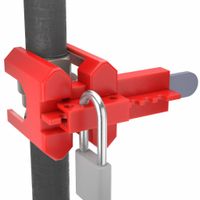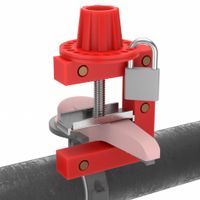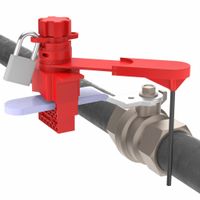Call +(254) 703 030 000 / 751 483 999 / 721 704 777
- Home
- Safety
- Lockout Tagout
- Valve Lockout Devices
.....Read More
Frequently Asked Questions
What is a valve lockout device?
A valve lockout device is a safety mechanism used to ensure that a valve remains in a specific position, either open or closed, to prevent accidental or unauthorized operation. These devices are crucial in industrial and commercial settings where the inadvertent operation of a valve could lead to hazardous situations, such as the release of toxic substances, explosions, or equipment damage.
Valve lockout devices are part of a broader safety protocol known as Lockout/Tagout (LOTO), which is designed to protect workers from the unexpected energization or startup of machinery and equipment during maintenance or servicing. By securing a valve in place, these devices help maintain a safe working environment and comply with occupational safety regulations.
There are various types of valve lockout devices tailored to different valve designs, including gate valves, ball valves, butterfly valves, and plug valves. Each type is engineered to fit securely over the valve handle or stem, preventing it from being turned or moved. Common materials used in the construction of these devices include durable plastics, metals, or a combination of both, ensuring they can withstand harsh industrial environments.
Installation of a valve lockout device typically involves placing the device over the valve handle and securing it with a padlock. The padlock is then locked, and only authorized personnel with the key can remove it, ensuring controlled access. Some devices also feature a tagout component, which provides additional information about the lockout, such as the reason for the lockout, the person responsible, and the date of implementation.
Overall, valve lockout devices are essential tools in maintaining safety and preventing accidents in environments where the control of fluid or gas flow is critical.
How do valve lockout devices work?
Valve lockout devices are safety mechanisms used to ensure that a valve remains in a closed or open position, preventing accidental operation during maintenance or repair work. These devices are crucial in industrial settings to protect workers from hazardous energy releases.
The operation of valve lockout devices involves several key steps:
1. **Selection**: Choose the appropriate lockout device based on the type of valve (e.g., gate, ball, butterfly) and its size. Devices are designed to fit specific valve types and sizes to ensure a secure lockout.
2. **Installation**: The device is installed on the valve handle or control mechanism. For example, a gate valve lockout might encase the handwheel, while a ball valve lockout clamps over the handle to prevent movement.
3. **Securing**: Once the device is in place, it is secured using a padlock. The padlock ensures that the lockout device cannot be removed without a key or combination, effectively immobilizing the valve.
4. **Tagging**: A tag is often attached to the lockout device, providing information about the lockout, such as the person responsible, the date, and the reason for the lockout. This tag serves as a warning to others that the valve should not be operated.
5. **Verification**: After installation, it is crucial to verify that the valve is indeed locked out and cannot be operated. This step ensures the effectiveness of the lockout process.
Valve lockout devices are part of a broader lockout/tagout (LOTO) safety protocol, which is designed to protect workers from unexpected energization or release of hazardous energy during service activities.
Why are valve lockout devices important for safety?
Valve lockout devices are crucial for safety because they prevent the accidental or unauthorized operation of machinery and equipment during maintenance or repair activities. These devices ensure that energy sources are isolated and cannot be turned on until the lockout device is removed by the person who applied it. This is vital for several reasons:
1. **Prevention of Accidents**: By securing valves in the off position, lockout devices prevent the unexpected release of hazardous energy, which could lead to serious injuries or fatalities. This is particularly important in industries dealing with high-pressure systems, toxic chemicals, or extreme temperatures.
2. **Compliance with Regulations**: Many safety regulations and standards, such as OSHA in the United States, mandate the use of lockout/tagout procedures to protect workers. Non-compliance can result in legal penalties and increased liability for companies.
3. **Protection of Equipment**: Lockout devices help prevent damage to machinery by ensuring that maintenance is performed safely and correctly. This reduces the risk of costly repairs and downtime.
4. **Clear Communication**: Lockout devices often include tags that provide information about the maintenance being performed and the person responsible. This enhances communication among workers and ensures that everyone is aware of the status of the equipment.
5. **Safety Culture**: Implementing lockout/tagout procedures fosters a culture of safety within an organization. It demonstrates a commitment to worker safety and encourages employees to prioritize safe practices.
In summary, valve lockout devices are a critical component of workplace safety, protecting both workers and equipment from the dangers associated with uncontrolled energy release.
What types of valves can be secured with lockout devices?
Gate valves, ball valves, butterfly valves, plug valves, globe valves, and needle valves can be secured with lockout devices.
How do you install a valve lockout device?
To install a valve lockout device, follow these steps:
1. **Identify the Valve**: Determine the type of valve (e.g., gate, ball, butterfly) and ensure the lockout device is compatible.
2. **Prepare for Shutdown**: Inform all affected personnel about the lockout procedure. Ensure the valve is in the off or closed position.
3. **Select the Right Device**: Choose a lockout device designed for the specific valve type and size. Ensure it meets safety standards.
4. **Isolate Energy Sources**: Turn off the energy source controlling the valve. This may involve shutting down machinery or systems connected to the valve.
5. **Apply the Lockout Device**:
- **Gate Valve**: Place the lockout device over the valve handle, ensuring it covers the entire handle to prevent movement.
- **Ball Valve**: Position the lockout device over the valve lever, securing it in place to prevent the lever from turning.
- **Butterfly Valve**: Attach the lockout device to the valve handle, ensuring it restricts movement.
6. **Secure with a Lock**: Insert a padlock through the lockout device's designated hole. Lock it to prevent removal. Use a lock with a unique key or combination.
7. **Tag the Device**: Attach a tag to the lockout device indicating the reason for the lockout, the person responsible, and the date. This provides clear communication to others.
8. **Verify Isolation**: Double-check that the valve is securely locked and cannot be operated. Attempt to turn the valve to ensure it is immobilized.
9. **Communicate**: Inform all relevant personnel that the valve is locked out and provide details on the lockout procedure.
10. **Document the Process**: Record the lockout procedure in the appropriate logs for compliance and safety audits.
What is the difference between specific and universal valve lockout devices?
Specific valve lockout devices are designed to fit a particular type or model of valve. They are tailored to lock out specific valve designs, such as ball valves, gate valves, or butterfly valves, ensuring a secure fit and effective lockout. These devices are ideal for situations where the same type of valve is used consistently across a facility, providing a precise and reliable lockout solution.
Universal valve lockout devices, on the other hand, are versatile and adjustable, capable of fitting a wide range of valve types and sizes. They are designed to accommodate various valve configurations, making them suitable for facilities with diverse valve types. Universal devices offer flexibility and convenience, as they can be used across different applications without the need for multiple specific devices.
In summary, specific valve lockout devices offer a tailored fit for particular valve types, ensuring maximum security and effectiveness, while universal valve lockout devices provide adaptability and versatility for use with multiple valve types and sizes.
How do valve lockout devices comply with OSHA standards?
Valve lockout devices comply with OSHA standards by adhering to the requirements set forth in the OSHA standard 29 CFR 1910.147, which governs the control of hazardous energy (lockout/tagout). These devices are designed to ensure that machinery and equipment are properly shut off and not able to be started up again prior to the completion of maintenance or servicing work.
1. **Isolation of Energy Sources**: Valve lockout devices physically isolate energy sources by locking valves in the off position, preventing the release of hazardous energy. This is crucial for compliance with OSHA's requirement to control energy sources during maintenance.
2. **Durability and Standardization**: OSHA requires lockout devices to be durable and standardized. Valve lockout devices are made from robust materials that can withstand environmental conditions and are designed to fit various valve types, ensuring they meet these durability and standardization criteria.
3. **Identification**: These devices are often brightly colored and can be labeled to identify the person responsible for the lockout, complying with OSHA's requirement for clear identification to prevent accidental removal.
4. **Exclusive Control**: OSHA mandates that lockout devices must be under the exclusive control of the authorized employee performing the maintenance. Valve lockout devices typically use padlocks that only the authorized employee can unlock, ensuring compliance with this requirement.
5. **Training and Procedures**: OSHA requires employers to establish a lockout/tagout program that includes training employees on the use of lockout devices. Valve lockout devices are integral to these programs, and their proper use is part of the training to ensure compliance.
By meeting these criteria, valve lockout devices help organizations comply with OSHA standards, ensuring the safety of workers during maintenance and servicing activities.



